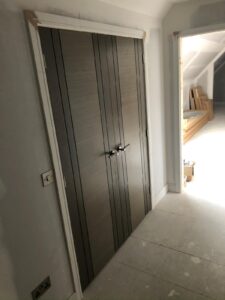 Common Carpentry Repairs in Paisley
Common Carpentry Repairs in Paisley
Introduction
From squeaky doors to loose floorboards, carpentry problems are common in many Paisley homes. This section of our guide provides practical tips for tackling some of the most frequent carpentry repairs. While some issues can be addressed with simple DIY solutions, others require the expertise of a professional. We’ll help you determine when to tackle the job yourself and when to call in Glasgow Handyman Solutions.
1. How to Fix a Squeaky Door
Description: A squeaky door is a common household annoyance, often caused by friction between the hinge plates. While usually a simple fix, it’s important to address it promptly to prevent further wear and tear on the hinges.
DIY Solutions:
- Clean the Hinges: Start by thoroughly cleaning the hinges to remove any dirt, dust, rust, or grime. Use a clean cloth or an old toothbrush to get into the crevices.
- Lubricate the Hinges: Apply a lubricant to the hinges to reduce friction. Good options include:
- Silicone spray: Provides long-lasting lubrication and is less likely to attract dirt.
- WD-40: A common household lubricant, but it can attract dust over time.
- Petroleum jelly: A thicker lubricant that can be effective, but may also attract dirt.
- Apply the lubricant directly to the hinge pins and the spaces between the hinge plates.
- Open and close the door several times to distribute the lubricant evenly.
- Tighten Hinge Screws: Loose hinge screws can also contribute to squeaking. Use a screwdriver to check and tighten any loose screws on both the door and the door frame.
- Check Hinge Alignment: Inspect the hinges to make sure they are properly aligned. If the door is sagging or not hanging straight, the hinges may need to be adjusted. This can be a more complex task, so consider calling a professional if you’re unsure.
- Replace Damaged Hinges: If the hinges are bent, severely rusted, or otherwise damaged, they may need to be replaced. This is a more involved repair, and you might want to consult a professional.
- Sand or Trim the Door: If you notice the door rubbing against the frame, that could be the source of the squeak. Identify the areas where rubbing occurs. You can lightly sand down these areas using sandpaper. If more significant trimming is needed, you may need to remove the door and use a plane.
- Use Door Shims: If the door is uneven or not properly aligned within the frame, door shims can be used to adjust its position. These are small, wedge-shaped pieces of wood that can be inserted between the hinge and the door frame to make adjustments.
- Upgrade Hardware: If the hinges are old or of poor quality, consider upgrading to higher-quality hinges. Nylon or ball-bearing hinges are designed to minimize friction and operate more smoothly.
When to Call a Professional:
- If you’re not comfortable working with tools or disassembling door hardware.
- If the squeak persists after trying these DIY solutions.
- If the hinges are severely damaged or if the door needs significant adjustments.
- If you suspect a more serious problem with the door frame or alignment.
Internal Link: https://glasgow-handymansolutions.co.uk/door-repair-and-fitting-glasgow/
External Link: [invalid URL removed] (The Family Handyman – Reputable DIY Website)
2. How to Repair a Sticking Window
Description: Sticking windows are a common problem, especially in older homes. They can be caused by a variety of factors, including warped wood, accumulated dirt and grime, or changes in humidity.
DIY Solutions:
- Clean the Tracks: Start by thoroughly cleaning the window tracks. Remove any dirt, debris, or old lubricant using a brush, vacuum, or damp cloth.
- Lubricate the Tracks: Apply a silicone-based lubricant to the tracks. Avoid using oil-based lubricants as they can attract dirt.
- Check for Obstructions: Inspect the tracks for any obstructions, such as loose screws or pieces of debris.
- Adjust the Rollers (for sliding windows): If you have sliding windows, check the rollers at the bottom. They may need to be cleaned, lubricated, or adjusted.
- Sand or Plane (if necessary): If the window frame is warped, you may need to carefully sand or plane down the areas where the window is sticking. This is a more advanced repair.
When to Call a Professional:
- If the window is severely warped or damaged.
- If you’re not comfortable working with tools or making adjustments to the window frame.
- If the problem persists after trying these DIY solutions.
- If you suspect a problem with the window’s foundation or the surrounding structure.
Internal Link: https://glasgow-handymansolutions.co.uk/ (Link to your homepage, add a note “Contact us for window repairs”)
External Link: [invalid URL removed] (This Old House – Reputable Home Improvement Website)
3. How to Patch a Hole in Drywall
Description: Small holes and cracks in drywall are common occurrences in most homes. Fortunately, patching them is a relatively straightforward DIY task.
DIY Solutions:
- Prepare the Area: Clean the area around the hole and remove any loose debris.
- Apply Patching Compound: For small holes, use a spackling compound. Apply it with a putty knife, filling the hole completely.
- Apply Joint Compound (if necessary): For larger holes use a drywall repair patch.
- Sand and Smooth: Once the compound is dry, sand it smooth using fine-grit sandpaper.
- Prime and Paint: Apply a primer to the patched area, let it dry, and then paint to match the surrounding wall.
When to Call a Professional:
- If the hole is very large or if there is significant damage to the drywall.
- If you’re not comfortable working with patching compound or if you don’t have the necessary tools.
- If you want a seamless, professional finish.
Internal Link: https://glasgow-handymansolutions.co.uk/ (Link to your homepage and add a note: “Contact us for plastering and wall repairs”)
External Link: https://www.lowes.com/n/how-to/patch-and-repair-drywall (Lowe’s – Reputable Home Improvement Retailer)
4. Repairing Loose Floorboards
Description: Loose or squeaky floorboards are not only annoying but can also be a tripping hazard. This is often caused by the boards shrinking or expanding over time, or by loose nails.
DIY Solutions:
- Locate the Loose Board: Identify the loose or squeaky floorboard.
- Re-secure the Board:
- Using Nails: If the board is nailed down, try hammering in the existing nails. If that doesn’t work, use new nails slightly longer than the originals, driving them in at an angle.
- Using Screws: For a more secure fix, use screws. Drill pilot holes first to avoid splitting the wood.
- Fill Gaps (if necessary): If there are gaps between the boards, you can fill them with wood putty or a mixture of sawdust and wood glue.
When to Call a Professional:
- If the floorboards are severely damaged or rotted.
- If the squeaking or looseness persists after trying these solutions.
- If you suspect a problem with the subfloor or joists.
Internal Link: https://glasgow-handymansolutions.co.uk/ (Link to your homepage and add note: “Contact us for floor repairs”)
External Link: [invalid URL removed] (DIY Network – Reputable DIY and Home Improvement Website)
5. Repairing/Replacing Damaged Skirting Boards or Architraves
Description: Skirting boards and architraves add a finishing touch to a room but can become damaged over time. Repairing or replacing them can significantly improve the appearance of your space.
DIY Solutions:
- Assess the Damage: Determine whether the skirting board or architrave can be repaired or needs to be replaced.
- Repairing:
- Small cracks or holes: Fill with wood filler, sand smooth, and repaint.
- Loose sections: Re-secure with nails or screws.
- Replacing:
- Remove the damaged section: Carefully pry off the damaged section using a chisel or pry bar.
- Measure and cut the new piece: Measure the length needed and cut a new piece of skirting board or architrave to match.
- Install the new piece: Attach the new piece using nails, screws, or adhesive.
- Finish: Fill any gaps, sand, prime, and paint the repaired or replaced section.
When to Call a Professional:
- If the damage is extensive.
- If you’re not comfortable working with the necessary tools.
- If you want a professional, seamless finish.
https://glasgow-handymansolutions.co.uk/ (Link to your homepage and add note “Contact us for carpentry repairs”)
6. Fixing a Loose Stair Railing
Description: A loose stair railing is a serious safety hazard. It’s crucial to address this problem promptly and securely.
DIY Solutions:
- Identify Loose Components: Determine which parts of the railing are loose (e.g., balusters, newel post, handrail).
- Tighten Screws and Bolts: Use a screwdriver or wrench to tighten any loose screws or bolts.
- Use Wood Glue: For loose balusters, apply wood glue to the joints and clamp them until the glue dries.
- Add Reinforcements: If necessary, add extra screws, brackets, or supports to reinforce the railing.
When to Call a Professional:
- If the railing is severely damaged or unstable.
- If you’re not comfortable working on stairs or with the necessary tools.
- If the problem persists after trying these solutions.
- If you’re unsure about the structural integrity of the staircase.
Internal Link: https://glasgow-handymansolutions.co.uk/ (Link to your homepage, add note “Contact us for stair railing repairs”)
External Link: [invalid URL removed] (Richard Burbidge – Stair Part Manufacturer with Safety Advice)
When to Call a Professional Handyman
While many minor carpentry repairs can be tackled as DIY projects, it’s always best to err on the side of caution. Call a professional handyman like Glasgow Handyman Solutions if:
* You are unsure about any of the steps involved.
* You lack the necessary tools or expertise.
* The repair involves structural elements of your home.
* You want a guaranteed, professional finish.
Why Choose Glasgow Handyman Solutions for Your Carpentry Repairs?
At Glasgow Handyman Solutions, we’re committed to providing Paisley homeowners with reliable, efficient, and high-quality handyman services. We have the expertise and experience to handle all your carpentry repairs, big or small. We pride ourselves on:
- Professionalism: We arrive on time, complete the work to a high standard, and leave your home clean and tidy.
- Quality Workmanship: We use the right tools and techniques to ensure a professional finish every time.
- Customer Satisfaction: We’re committed to your satisfaction and guarantee our work.
- Competitive Pricing: We offer fair and transparent pricing for all our services.
Ready to tackle those carpentry repairs? Contact Glasgow Handyman Solutions today for a free quote! #
